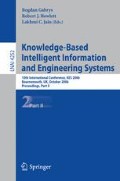Abstract
In this paper we propose a split and merge texture segmentation method. The presented approach is characterised by the introduction of a novel operator, the Local Fuzzy Pattern for texture discrimination, and the employment of a neuro-fuzzy decision support strategy, which supervises the overall split and merge procedure. The effectiveness of the proposed approach is evaluated on a set of artificial and natural texture images.
Access this chapter
Tax calculation will be finalised at checkout
Purchases are for personal use only
Preview
Unable to display preview. Download preview PDF.
References
Brodatz, P.: Textures: A photographic Album for Artists and Designers (1966)
Castellano, G., Castiello, C., Fanelli, A.M., Mencar, C.: Knowledge discovering by a neuro-fuzzy modeling framework. Fuzzy Sets Syst. 149(1), 187–207 (2005)
Goltsev, A.: An Assembly Neural Network for Texture Segmentation. Neural Networks 9(4), 643–653 (1996)
Karmakar, G., Dooley, L., Murshed, M.: Fuzzy rule for image segmentation incorporating texture features. In: Proc. Int. Conf. Image Processing, vol. 1, pp. 797–800 (2002)
Ojala, T., Pietikäinen, M.: Unsupervised texture segmentation using feature distributions. Pattern Recognition 32, 477–486 (1999)
Pietikainen, M.K.: Texture Analysis in Machine Vision. World Scientific, Singapore (2000)
Sklansky, J.: Image segmentation and feature extraction. IEEE Trans. Syst. Man Cybern. 8, 237–247 (1978)
Si, W.L., He, X.: Textured image segmentation using autoregressive model and artificial neural network. Pattern Recognition 28(12), 1807–1817 (1995)
Sokal, R.R., Rohlf, F.J.: Introduction to Biostatistics. Freeman and Co, New York (1987)
Tuceryan, M., Jain, A.K.: Texture Analysis. In: The Handbook of Pattern Recognition and Computer Vision, World Scientific, Singapore (1998)
MIT Vision Texture (VisTex) database, http://www-white.media.mit.edu/vismod/imagery/VisionTexture/vistex.html
Author information
Authors and Affiliations
Editor information
Editors and Affiliations
Rights and permissions
Copyright information
© 2006 Springer-Verlag Berlin Heidelberg
About this paper
Cite this paper
Caponetti, L., Castiello, C., Fanelli, A.M., Górecki, P. (2006). Texture Segmentation with Local Fuzzy Patterns and Neuro-fuzzy Decision Support. In: Gabrys, B., Howlett, R.J., Jain, L.C. (eds) Knowledge-Based Intelligent Information and Engineering Systems. KES 2006. Lecture Notes in Computer Science(), vol 4252. Springer, Berlin, Heidelberg. https://doi.org/10.1007/11893004_44
Download citation
DOI: https://doi.org/10.1007/11893004_44
Publisher Name: Springer, Berlin, Heidelberg
Print ISBN: 978-3-540-46537-9
Online ISBN: 978-3-540-46539-3
eBook Packages: Computer ScienceComputer Science (R0)

